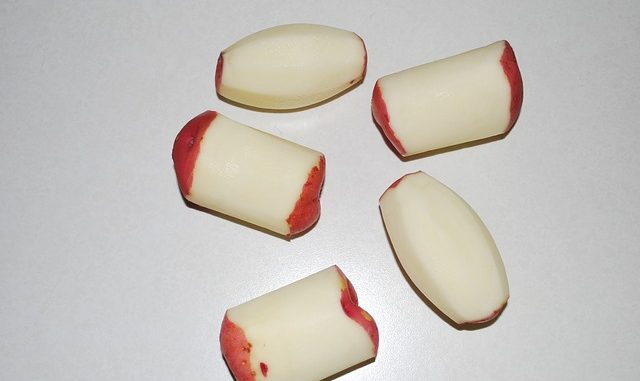
Starch is the main storage polysaccharide in higher plants and their primary energy source. It is sometimes referred to by some sources as amylum but this is falling out of favour.
Starch is found in all higher plants. It is of vital importance in cereals such as rice and wheat but also in tubers such as potato and cassava. It is a polymer mixture of linear and branched α-D-glucose molecules, all joined by glycosidic bonds.
Starch is the most important carbohydrate in the human diet. Trying to understand its performance in food science is one of the big science topics of our day. Pure starch has no flavour or aroma. It is a white powder that is largely insoluble in cold water and alcohol. Starch is often exploited for these properties and is a raw materials for other foodstuffs including sugar syrups and other sweetening ingredients.
The range of applications is staggering in breadth and scope. As well as forming the raw materials for the sweetener industry, it is used extensively in the paper and cardboard manufacturing industries, in animal feed and pet food, in various industrial biotechnical applications and as a feedstock for the pharmaceutical and cosmetic industries.
We find starch in the form of granules, where it is partially crystalline and amorphous. The granule morphology, shape, chemical composition and supermolecular structure are characteristic for each plant species. Genetic and environmental factors influence the way starch structure develops, not only between different plant species but also within the same species because of location, genetic variation, growing conditions etc.
Wheat starch is often described in terms of its granule size. Especially when it is being extracted from this cereal. A-starch consists of larger granules of between 25 and 35 microns in size. B-starch refers to granules which ten fold smaller being between 2 and 8 microns.
The behaviour of starch is down to two different but major carbohydrate components, each of a very high molecular weight. These are amylose and amylopectin. Their physical organization as macromolecules and polymers is fundamental to granule structure as is their biochemical behaviour and functional properties.
Amylose and amylopectin represent approximately 98–99% of the dry weight of starch granules.
The ratio of the two polysaccharides varies according to the botanical origin of the starch. Amylopectin is the major component in most starches, with the amylopectin content varying from close to 100% as in in waxy starches from wheat, barley, maize, and rice to less than 30% found in wrinkled peas and amylomaizes. A third component called intermediate materials or intermediate starch, has been identified in some starches (Lansky et al., 1949) but discussion still occurs as to whether this material should be classified as amylose or amylopectin or as a separate component.
Amylose
Amylose has a molecular weight range of approximately 105- 106 kDaltons, corresponding to a degree of polymerization (DP) of 1000 to 10,000 glucose units. The units are sometimes described as glucan units. The vast majority of linking between glucose units is α[1→4]. Less than 0.5% of the glucose units in amylose are in α[1→6] linkages, resulting in a low degree of branching, and a structure with three to eleven chains of approximately 200-700 glucose residues per molecule.
Because of the low degree of branching, dissolved amylose has a tendency to form insoluble semi-crystalline aggregates, depending on the placing of the branches in the structure. This aspects of its structural chemistry makes it an important feature of the starch granule.
Amylose is mostly located in the amorphic regions of the granule and only in the external lamellas of the crystalline regions (Chen et al., 2004). Starch contents vary considerably.
Native starches generally contain 20% to 30% amylose, although most pulse starches have higher amylose content (Hoover et al., 2010; Wang et al., 2011). The amylose content of potato starch varies from 23% to 31% for normal potato genotypes (Kim et al., 1995; Wisenborn et al., 1994).
Amylopectin
Amylopectin is a much larger polymer, with a molecular weight about 108 kDal. and a Degree of Polymerization (DP) that may exceed one million.
Most starches contain between 60 to 90% amylopectin, although high amylose starches exist, with as little as 30% amylopectin, whilst waxy starches with essentially 100% amylopectin are well known.
Amylopectin has about 5% of its glucoses in α[1→6] linkages, giving it a highly branched, tree-like structure and a complex molecular architecture that can vary substantially between different starches with regard to placement and length of branches.
The amylopectin branches may be classified according to their pattern of substitution: A-chains are defined as unsubstituted, B-chains are substituted by other chains, and there is a single C-chain that carries the reducing glucose.
Glycogen, a storage polysaccharide of animals, has the same chemical composition as amylopectin but it has a higher degree of branching giving it a more compact globular shape. More glucose can be packed into the open ended, tree-like structure of amylopectin than in the more closed, globular configuration of glycogen. Starch is not known in animals save as a source of carbohydrate steadily being digested in the gut as and when it is consumed.
The Structure Of Starch Granules
A starch granule is surprisingly complex with a hierarchy of structure. The diameter ranges from less than 1 mm to about 100 mm. Generally, cereals have small granules compared to roots or tubers
Native starch occurs mostly in the form of semi-crystalline granules of amylose with amylopectin, Their ordering in the granule which produces a very complex hierarchical structure. The order of structure is granule to growth ring, blocklet, super-helix, lamellae and finally starch double helix in that order.
Starch granules are generally composed of an amorphous bulk core area surrounded by concentric semicrystalline growth rings alternating with amorphous growth rings (Wang and Copeland, 2015). The amorphous core, as observed by scanning electron microscopy (SEM) and transmission electron microscopy (TEM), is composed mainly of amylose and amylopectin chains disordered at the reducing end (Wang and Copeland, 2012). The size of the amorphous core is related to the amylose content of starch; waxy maize starch granules had the smallest core compared to normal and high amylose maize starch, with the latter having the largest core (Li et al., 2003).
Starch granules can be examined on at least 5 levels of structure, ranging in scale from nano- to micrometer. The largest scale is the intact granule, which varies in size from 1 to 100 μm. At a level down from this macrostructural scale are the alternating semicrystalline and amorphous growth rings. The semicrystalline growth rings are proposed to decrease in thickness from 450 to 550 nm, for those closer to the core, to 80 to 160 nm for rings near the periphery (Wang and Copeland, 2012). The amorphous growth rings appear to be uniform in width and much thinner (60 to 80 nm) than the semicrystalline growth rings (Wang and Copeland, 2015).
At the next level down are “blocklet” structural elements, which are proposed to vary in size from 20 to 500 nm (Gallant et al., 1997). Small blocklets (20 nm) are proposed to be located mainly in amorphous growth rings, and the large blocklets (50 to 500 nm) in semicrystalline growth rings (Gallant et al., 1997; Baldwin et al., 1998; Perez et al., 2009; Perez and Bertoft, 2010).
At a smaller size scale than “blocklets” are the left-handed superhelices, which are suggested to have a width of approximately 18 nm and a pitch of 10 nm based on electron optical tomography and cryo-electron diffraction experiments (Oostergetel and van Bruggen, 1993). The structural elements beneath super-helices are crystalline and amorphous lamellae with a periodicity of 9 nm. The smallest unit of starch structural organization is the individual glucosyl unit of 0.3 to 0.5 nm in length (Biliaderis, 2009).
References
Baldwin, P. M., Adler, J., Davies, M. C., & Melia, C. D. (1998). High resolution imaging of starch granule surfaces by atomic force microscopy. Journal of Cereal Science, 27(3), pp. 255-265 (Article).
Biliaderis, C. G. (2009). Structural transitions and related physical van Bruggenproperties of starch. In: Starch 3rd edt. Academic Press pp. 293-372 (Article)
Gallant, D. J., Bouchet, B., & Baldwin, P. M. (1997). Microscopy of starch: evidence of a new level of granule organization. Carbohydrate Polymers, 32(3-4), pp. 177-191 (Article).
Oostergetel, G. T., & van Bruggen, E. F. (1993). The crystalline domains in potato starch granules are arranged in a helical fashion. Carbohydrate Polymers, 21(1), pp. 7-12 (Article).

I noticed General Mills use your writing in their marketing blurb.